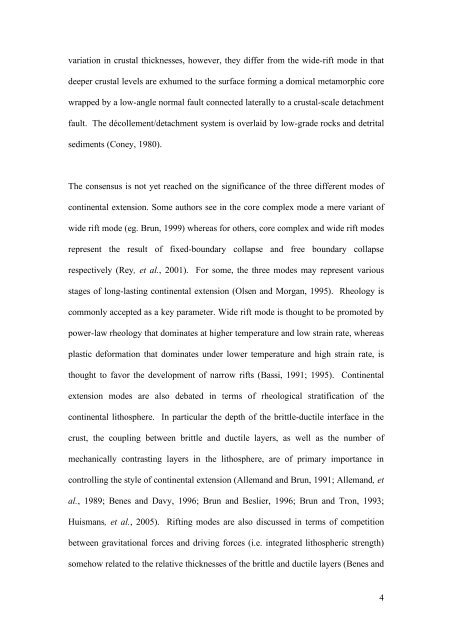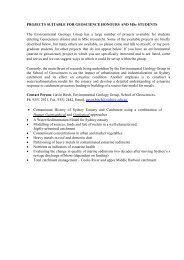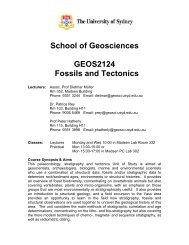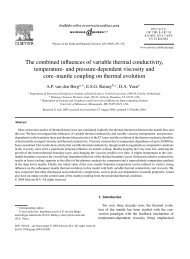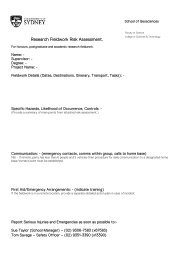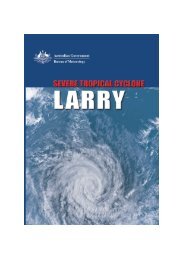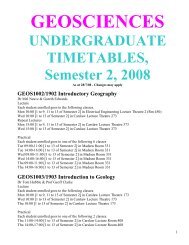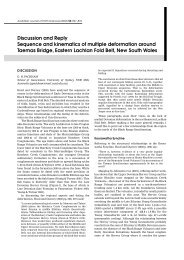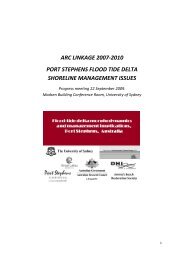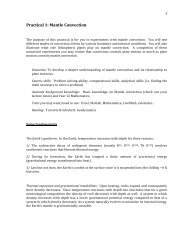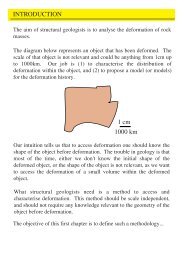Effects of Initial Weakness on Rift Architecture - School of Geosciences
Effects of Initial Weakness on Rift Architecture - School of Geosciences
Effects of Initial Weakness on Rift Architecture - School of Geosciences
You also want an ePaper? Increase the reach of your titles
YUMPU automatically turns print PDFs into web optimized ePapers that Google loves.
variati<strong>on</strong> in crustal thicknesses, however, they differ from the wide-rift mode in that<br />
deeper crustal levels are exhumed to the surface forming a domical metamorphic core<br />
wrapped by a low-angle normal fault c<strong>on</strong>nected laterally to a crustal-scale detachment<br />
fault. The décollement/detachment system is overlaid by low-grade rocks and detrital<br />
sediments (C<strong>on</strong>ey, 1980).<br />
The c<strong>on</strong>sensus is not yet reached <strong>on</strong> the significance <str<strong>on</strong>g>of</str<strong>on</strong>g> the three different modes <str<strong>on</strong>g>of</str<strong>on</strong>g><br />
c<strong>on</strong>tinental extensi<strong>on</strong>. Some authors see in the core complex mode a mere variant <str<strong>on</strong>g>of</str<strong>on</strong>g><br />
wide rift mode (eg. Brun, 1999) whereas for others, core complex and wide rift modes<br />
represent the result <str<strong>on</strong>g>of</str<strong>on</strong>g> fixed-boundary collapse and free boundary collapse<br />
respectively (Rey, et al., 2001). For some, the three modes may represent various<br />
stages <str<strong>on</strong>g>of</str<strong>on</strong>g> l<strong>on</strong>g-lasting c<strong>on</strong>tinental extensi<strong>on</strong> (Olsen and Morgan, 1995). Rheology is<br />
comm<strong>on</strong>ly accepted as a key parameter. Wide rift mode is thought to be promoted by<br />
power-law rheology that dominates at higher temperature and low strain rate, whereas<br />
plastic deformati<strong>on</strong> that dominates under lower temperature and high strain rate, is<br />
thought to favor the development <str<strong>on</strong>g>of</str<strong>on</strong>g> narrow rifts (Bassi, 1991; 1995). C<strong>on</strong>tinental<br />
extensi<strong>on</strong> modes are also debated in terms <str<strong>on</strong>g>of</str<strong>on</strong>g> rheological stratificati<strong>on</strong> <str<strong>on</strong>g>of</str<strong>on</strong>g> the<br />
c<strong>on</strong>tinental lithosphere. In particular the depth <str<strong>on</strong>g>of</str<strong>on</strong>g> the brittle-ductile interface in the<br />
crust, the coupling between brittle and ductile layers, as well as the number <str<strong>on</strong>g>of</str<strong>on</strong>g><br />
mechanically c<strong>on</strong>trasting layers in the lithosphere, are <str<strong>on</strong>g>of</str<strong>on</strong>g> primary importance in<br />
c<strong>on</strong>trolling the style <str<strong>on</strong>g>of</str<strong>on</strong>g> c<strong>on</strong>tinental extensi<strong>on</strong> (Allemand and Brun, 1991; Allemand, et<br />
al., 1989; Benes and Davy, 1996; Brun and Beslier, 1996; Brun and Tr<strong>on</strong>, 1993;<br />
Huismans, et al., 2005). <strong>Rift</strong>ing modes are also discussed in terms <str<strong>on</strong>g>of</str<strong>on</strong>g> competiti<strong>on</strong><br />
between gravitati<strong>on</strong>al forces and driving forces (i.e. integrated lithospheric strength)<br />
somehow related to the relative thicknesses <str<strong>on</strong>g>of</str<strong>on</strong>g> the brittle and ductile layers (Benes and<br />
4


